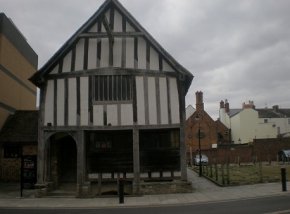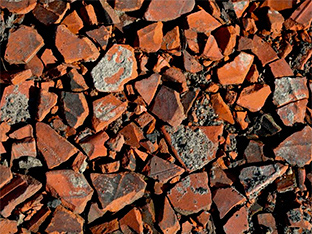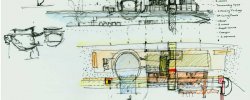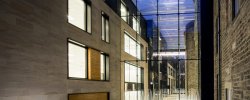17th century houses
Celtic Homes
The Celts lived in round houses. They were built around a central pole with horizontal poles radiating outwards from it. They rested on vertical poles. Walls were of wattle and daub and roofs were thatched. Around the walls inside the huts were benches, which also doubled up as beds. The Celts also used low tables.
Roman Homes
After the Roman Conquest upper class Celts adopted the Roman way of life. They built villas modeled on Roman buildings and they enjoyed luxuries such as mosaics and even a form of central heating called a hypocaust. Wealthy Romans also had wall paintings called murals in their houses. In their windows they had panes of glass. Of course poorer Romans had none of these things. Their houses were simple and plain and the main form of heating was braziers.
For the wealthy furniture was very comfortable. It was upholstered and finely carved. People ate while reclining on couches. Oil lamps were used for light. Furthermore some people had a piped water supply. Water was brought into towns in aqueducts they went along lead pipes to individual houses.
However Roman rule probably made little difference to most poor Celts, especially in the north and extreme southwest of England. For them life went on much as it had before. Their houses remained simple huts.
Saxon Homes
Life was hard in Anglo-Saxon times and homes were rough. There were no panes of glass in windows, even in a thane's (noble's) hall and there were no chimneys. Floors were of earth or sometimes they were dug out and had wooden floorboards placed over them. There were no carpets.
Rich people's houses were rough, crowded and uncomfortable. Even a thanes hall was really just a large wooden hut although it was usually hung with rich tapestries. Thanes also like to show off any gold they owned. Any furniture must have been simple and heavy such as wooden chests.
A Peasants Hut In The Middle Ages
Peasants homes were simple wooden huts. They had wooden frames filled in with wattle and daub (strips of wood woven together and covered in a 'plaster' of animal hair and clay). However in some parts of the country huts were made of stone. Peasants huts were either whitewashed or painted in bright colors.
The poorest people lived in one-room huts. Slightly better off peasants lived in huts with one or two rooms. There were no panes of glass in the windows only wooden shutters, which were closed at night. The floors were of hard earth sometimes covered in straw for warmth.
In the middle of a Medieval peasant's hut was a fire used for cooking and heating. There was no chimney. Any furniture was very basic. Chairs were very expensive and no peasant could afford one. Instead they sat on benches or stools. They would have a simple wooden table and chests for storing clothes and other valuables. Tools and pottery vessels were hung on hooks. The peasants slept on straw and they did not have pillows. Instead they rested their heads on wooden logs.
The peasant's wife cooked on a cauldron suspended over the fire and the family ate from wooden bowls. Candles were expensive so peasants usually used rush lights (rushes dipped in animal fat).
At night in summer and all day in winter the peasants shared their huts with their animals. Parts of it were screened off for the livestock. Their body heat helped to keep the hut warm.
Rich People's Houses In The Middle Ages
The Normans, at first, built castles of wood. In the early 12th century stone replaced them. In the towns wealthy merchants began living in stone houses. (The first ordinary people to live in stone houses were Jews. They had to live in stone houses for safety).
In Saxon times a rich man and his entire household lived together in one great hall. In the Middle Ages the great hall was still the center of a castle but the lord had his own room above it. This room was called the solar. In it the lord slept in a bed, which was surrounded by curtains, both for privacy and to keep out drafs. The other members of the lord's household, such as his servants, slept on the floor of the great hall.
At one or both ends of the great hall there was a fireplace and chimney. In the Middle Ages chimneys were a luxury. As time passed they became more common but only a small minority could afford them. Certainly no peasant could afford one.
About 1180 for the first time since the Romans rich people had panes of glass in the windows. At first glass was very expensive and only rich people could afford it but by the late 13th and early 14th centuries the middle classes began to have glass in some of their windows. Those people who could not afford glass could use thin strips of horn or pieces of linen soaked in tallow or resin which were translucent.
Furniture in the Middle Ages was very basic. Even in a rich household chairs were rare. Most people sat on stools or benches. Rich people also had tables and large chests, which doubled up as beds. Rich peoples homes were hung with wool tapestries or painted linen. They were not just for decoration. They also helped keep out drafts.
In a castle the toilet or garderobe was a chute built into the thickness of the wall. The seat was made of stone. Sometimes the garderobe emptied straight into the moat!








